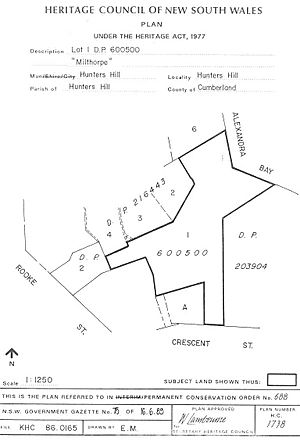Milthorpe, Hunters Hill facts for kids
Quick facts for kids Milthorpe, Hunters Hill |
|
|---|---|

Heritage boundaries
|
|
| Location | 12 Crescent Street, Hunters Hill, Municipality of Hunter's Hill, New South Wales, Australia |
| Built | 1872 |
| Architectural style(s) |
|
| Official name: Milthorpe; Atherslei | |
| Type | State heritage (built) |
| Designated | 2 April 1999 |
| Reference no. | 688 |
| Type | Villa |
| Category | Residential buildings (private) |
| Builders | Richard Sim |
| Lua error in Module:Location_map at line 420: attempt to index field 'wikibase' (a nil value). | |
Milthorpe is a special old house located at 12 Crescent Street in Hunters Hill. It is listed on a heritage register, which means it's an important historical place. This beautiful home, also known as Atherslei, was built in 1872 by Richard Sim. It was added to the New South Wales State Heritage Register on 2 April 1999.
Contents
The Story of Milthorpe
The land where Milthorpe stands was first given to a person named Mr. Morgan. Later, a man named Foss bought it in 1862. Milthorpe was once part of a much larger property. However, parts of the land were sold off over time. A big change happened in 1976 when new building lots were created, making Milthorpe's property smaller.
The house itself is believed to have been built in 1872. It was a large stone house with fourteen rooms. Around 1900, the house was updated. This remodelling gave it a new look, changing its style to what is known as Federation style.
Near the river, there was a stone wall to hold back the land. Some land was even added there in the early 1900s. There were also stone baths by the river until 1924. Today, a BBQ area stands where the baths used to be. Part of an old stone wall from the baths can still be seen near the water.
What Milthorpe Looks Like
Milthorpe is built on a raised area, set back from the river. This was a common way to build houses in Hunters Hill in the 1800s. It is a large stone house with a slate roof. The house faces north-east, looking out over grassy lawns and gardens towards the Lane Cove River.
Behind the main house, there is a garage and workshop. Near the water, there is a large boat shed and a cabana. There is also a swimming pool and a tennis court. A small, decorative building called a gazebo is in the garden north of the house. A stone wall marks the edge of the river.
Condition of the House
As of 2013, Milthorpe was in very good physical condition.
Changes Over Time
Milthorpe has been changed and updated several times:
- Around 1900: The house was remodelled, giving it its Federation style look.
- 1976: The land around the house was divided into smaller blocks.
- Around 1972: Some parts of the house were extended using sandstone.
- 1985: The inside of the house had maintenance and repair work done.
- After 1985: More changes, updates, and additions were made. For example, the gates were changed, and the cabana was replaced with a sandstone caretaker's cottage.
Why Milthorpe is a Heritage Site
Milthorpe is a great example of the large, grand houses built in Hunters Hill during the 1800s. It is one of the few big estates from that time that still has its original setting by the Lane Cove River. The house is also important because of its beautiful design and how it was changed from a Mid-Victorian to a Federation style.
Milthorpe was added to the New South Wales State Heritage Register on 2 April 1999 because it meets certain important standards.
Historical Importance
Milthorpe is one of the few old houses left in Sydney Harbour that is still privately owned. It has kept much of its original land and its connection to the water. Its location and setting show how houses were built along the waterfront in Hunters Hill in the 1800s.
Aesthetic Importance
Milthorpe is also important for its beauty. It is placed perfectly to look out over the water, with many large trees behind it. You can see the house clearly from a public wharf, from the ferry, and from the Lane Cove River itself. The wide, reclaimed land by the water adds to the house's charm. It shows how large waterfront gardens were used in the late 1800s and early 1900s.

